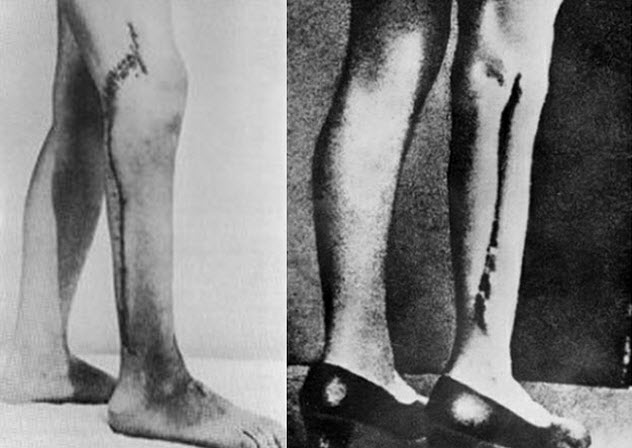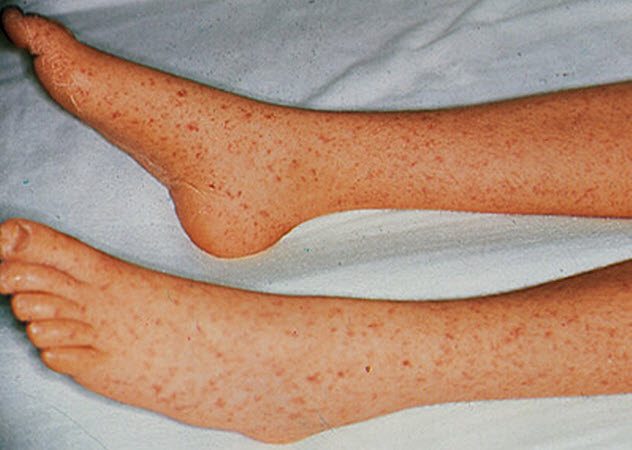 Our World
Our World  Our World
Our World  Pop Culture
Pop Culture 10 Incredible Female Comic Book Artists
 Crime
Crime 10 Terrifying Serial Killers from Centuries Ago
 Technology
Technology 10 Hilariously Over-Engineered Solutions to Simple Problems
 Miscellaneous
Miscellaneous 10 Ironic News Stories Straight out of an Alanis Morissette Song
 Politics
Politics 10 Lesser-Known Far-Right Groups of the 21st Century
 History
History Ten Revealing Facts about Daily Domestic Life in the Old West
 Weird Stuff
Weird Stuff 10 Everyday Products Surprisingly Made by Inmates
 Movies and TV
Movies and TV 10 Actors Dragged out of Retirement for One Key Role
 Creepy
Creepy 10 Lesser-Known Shapeshifter Legends from Around the World
 Our World
Our World 10 Science Facts That Will Change How You Look at the World
 Pop Culture
Pop Culture 10 Incredible Female Comic Book Artists
 Crime
Crime 10 Terrifying Serial Killers from Centuries Ago
Who's Behind Listverse?

Jamie Frater
Head Editor
Jamie founded Listverse due to an insatiable desire to share fascinating, obscure, and bizarre facts. He has been a guest speaker on numerous national radio and television stations and is a five time published author.
More About Us Technology
Technology 10 Hilariously Over-Engineered Solutions to Simple Problems
 Miscellaneous
Miscellaneous 10 Ironic News Stories Straight out of an Alanis Morissette Song
 Politics
Politics 10 Lesser-Known Far-Right Groups of the 21st Century
 History
History Ten Revealing Facts about Daily Domestic Life in the Old West
 Weird Stuff
Weird Stuff 10 Everyday Products Surprisingly Made by Inmates
 Movies and TV
Movies and TV 10 Actors Dragged out of Retirement for One Key Role
 Creepy
Creepy 10 Lesser-Known Shapeshifter Legends from Around the World
Top 10 Horrific Nazi Human Experiments
We can all agree that the things the Nazis did during World War II were horrible. The Holocaust was probably the crime for which they’re most infamous. But wretched and inhumane things happened in the concentration camps that most people don’t know about. Inmates were used as subjects in numerous experiments that were excruciatingly painful and usually resulted in death.
These are just 10 examples of the atrocious experiments they conducted. Consider this a trigger warning—things get somewhat gruesome from this paragraph on.
SEE ALSO: 10 Terrifying Nazi Doctors You’ve Never Heard Of.
10 Blood Coagulation Experiments

Dr. Sigmund Rascher conducted blood coagulation experiments on inmates at Dachau concentration camp. He had created a tablet, Polygal, which was made from beet and apple pectin. He believed that these tablets could help stop the bleeding from wounds in combat or surgery.
Each of his subjects was given a tablet and then shot in the neck or chest to test the efficacy of Polygal. Later on, those inmates would have their limbs amputated without any use of anesthesia. Dr. Rascher went on to establish a manufacturing company for the tablets with inmates as workers.[1]
9 Sulfonamide Experiments

Experiments on prisoners at Ravensbruck concentration camp tested the efficacy of sulfonamides (aka sulfa drugs). Subjects were deliberately wounded on the outer side of their calves. Physicians then rubbed a mixture of bacteria into the open wounds before sewing them shut. Glass splinters were also introduced into the wounds to mimic the situation in battles.[2]
However, this method proved to be too mild in comparison to conditions on the front lines. To simulate gunshot wounds, blood vessels were tied up on both sides to stop circulation. The subjects were then given sulfa drugs. Despite the advances these experiments made in the scientific and pharmaceutical fields, those inmates suffered horrible pain which resulted in permanent injury or even death.
8 Freezing And Hypothermia Experiments

The German armies were ill-prepared for the cold they faced on the Eastern Front, and thousands of soldiers died because of it. As a result, Dr. Sigmund Rascher conducted experiments at Birkenau, Auschwitz, and Dachau to determine two things: the time it takes to lower body temperature and cause death and the method to revive those who have been frozen.
Naked inmates were either put in an icy vat of water or locked outside in subzero temperatures. Most victims died. Those who merely lost consciousness underwent painful resuscitation procedures.
For resuscitation, subjects were placed under scorching sunlamps that burned their skin, forced to copulate with women for body heat, irrigated internally with boiling water, or placed in warm baths (which proved to be the most effective method).[3]
7 Incendiary Bomb Experiments

Over the course of three months in 1943 and 1944, experiments were conducted on inmates at Buchenwald concentration camp to test the effectiveness of pharmaceutical remedies on phosphorus burns inflicted by incendiary bombs.[4] Subjects were purposely burned with phosphorus matter from those bombs, which was severely painful. The inmates were seriously injured by these experiments.
6 Seawater Experiments

To find ways to make seawater drinkable, experiments were conducted on inmates at Dachau. The subjects were placed into four different groups: no water, seawater, seawater processed by the Berka method, and seawater without salt.[5]
The subjects were not given any food or drink other than what was assigned to their group. Those who received some type of seawater ended up suffering from severe diarrhea, convulsions, hallucinations, madness, and eventual death. Additionally, subjects were given either liver or spinal taps to gather data. The processes were torturous and, in most cases, fatal.
SEE ALSO: 10 Terrifying Nazi Doctors You’ve Never Heard Of
5 Experiments With Poison

Experiments were conducted at Buchenwald concentration camp to determine the effects of poisons on human beings. In 1943, poisons were secretly administered to the inmates.[6]
Some died directly due to the poisoned food. Others were killed for the sake of the autopsies. A year later, inmates were shot with poison-laced bullets for faster data collection. These subjects suffered tremendously.
4 Sterilization Experiments

As a part of the extermination of non-Aryans, Nazis doctors conducted mass sterilization experiments on inmates at different concentration camps to find the method that took the least time and money.
In one series of experiments, a chemical irritant was introduced into the female reproductive organs to block the fallopian tubes. Some women died from the procedure. Others were killed so that autopsies could be performed.
In another set of experiments, inmates were exposed to intense X-rays that caused severe burns on their stomachs, groins, and buttocks. They were also left with untreatable sores. Some subjects died.[7]
3 Bone, Muscle, And Nerve Regeneration And Bone Transplantation Experiments

For about a year, the processes to regenerate bones, muscles, and nerves were studied through experiments on inmates at Ravensbruck concentration camp. Nerve operations included removing segments of nerves from the lower parts of the limbs.
Experiments on bones include breaking and resetting bones in several places on the lower limbs. The fractures were not given enough time to properly heal because physicians wanted to study the healing process as well as test out various healing methods.[8]
The doctors also removed multiple sections of the subjects’ tibiae to study the regeneration of osseous tissues. Transplantations of bones included grafting segments of the left tibia onto the right and vice versa.
These experiments inflicted incredible pain on the inmates and caused permanent injuries for them.
2 Spotted Fever Experiments

From late 1941 to early 1945, physicians at Buchenwald and Natzweiler concentration camps conducted experiments on inmates for the benefit of the German armed forces. They were testing the effectiveness of spotted fever and other vaccines.
Approximately 75 percent of the subjects were given trial vaccines for spotted fever or nourished with other chemical substances. They were then injected with the virus. As a result, more than 90 percent of them died.[9]
The virus was introduced to the remaining 25 percent without any prior protection as a control group. Most of them didn’t make it. The physicians also conducted experiments associated with yellow fever, smallpox, typhus, and other diseases. Hundreds of inmates died, and many more suffered unbearable pain as a result.
1 Twin And Genetic Experiments

The goal of the Holocaust was to get rid of anyone who was not of Aryan descent. Jews, blacks, Hispanics, homosexuals, and others who did not meet the requirements were to be exterminated so that only the “superior” Aryan race would remain. Genetic experiments were conducted to provide the Nazi Party with scientific proof of the superiority of the Aryans.
Dr. Josef Mengele (aka “The Angel of Death”) was deeply fascinated by twins. He would have them separated from the other prisoners when they arrived at the Auschwitz concentration camp. Every day, the twins had to have their blood drawn. The true purpose of this routine is unknown.
Experiments on twins were extensive. They had to be carefully examined and have every inch of their bodies measured. Comparisons would then be made to determine hereditary traits. Occasionally, physicians performed mass transfusions of blood from one twin to another.
Since people of Aryan descent predominantly have blue eyes, experiments with chemical drops or iris injections would be conducted in an attempt to fabricate them. The procedures were incredibly painful, causing infections and even blindness.
Injections were administered and spinal taps were performed without any anesthesia. One twin would purposely be infected with a disease, while the other was not. If one died, the other was killed and examined for comparison.[10]
Amputations and organ removals were also done without anesthesia. Most twins that set foot in the camp ended up dead, and their autopsies became the final experiments.
+ High Altitude Experiments

Inmates at Dachau concentration camp were used as subjects from March to August of 1942 to test the limits of human endurance at high altitudes. The findings were to aid the German Air Force.
Subjects were placed in a low-pressure chamber which simulated atmospheric conditions at altitudes up to 21,000 meters (68,000 ft.). Most subjects died, and those who survived suffered exposure-related injuries.[11]
++ Malaria Experiments

For over three years, a series of experiments was conducted on more than 1,000 inmates at Dachau concentration camp in search of a treatment for malaria. Healthy inmates were infected by mosquitoes or extracts from those mosquitoes.
Subjects who contacted malaria were then treated with various drugs to test their efficacy. Many inmates died. Those who lived suffered painfully, and most were permanently disabled.[12]
Read about other atrocious human experiments during World War II with these 10 Atrocious Experiments Conducted By Unit 731.








